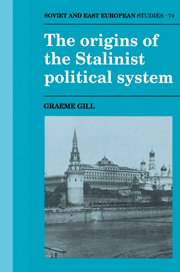Book contents
- Frontmatter
- Contents
- Preface
- Abbreviations
- Introduction: What is Stalinism?
- PART I COHESIVE OLIGARCHY 1917–1922
- 1 The structure of sub-national politics
- 2 The structure of elite politics
- PART II THE FRACTURED OLIGARCHY 1922–1929
- Part III THE RE-FORMED OLIGARCHY, 1930–1934
- PART IV THE OLIGARCHY SUBDUED, 1935–1941
- Conclusion: Why Stalinism?
- Notes
- Bibliography
- Index
- Soviet and East European Studies
2 - The structure of elite politics
Published online by Cambridge University Press: 11 September 2009
- Frontmatter
- Contents
- Preface
- Abbreviations
- Introduction: What is Stalinism?
- PART I COHESIVE OLIGARCHY 1917–1922
- 1 The structure of sub-national politics
- 2 The structure of elite politics
- PART II THE FRACTURED OLIGARCHY 1922–1929
- Part III THE RE-FORMED OLIGARCHY, 1930–1934
- PART IV THE OLIGARCHY SUBDUED, 1935–1941
- Conclusion: Why Stalinism?
- Notes
- Bibliography
- Index
- Soviet and East European Studies
Summary
The politics of the elite was conducted in an institutional arena which was constructed out of the chaos of revolutionary Russia. This arena was characterised by strong personalities and weak institutional structures, a combination which, like its counterpart at sub-national levels, was not accidental. The nature of this arena is important because of its effect upon the course of politics in the initial years of the Soviet regime. The weakness of the institutions, their inability to develop a powerful sense of integrity and coherence, was also to be important for the future development of the system as a whole.
The boundaries of the elite were neither clearly defined nor impervious to influences from below. In institutional terms, the elite encompassed members of the leading organs of the party-state structure, Sovnarkom, the Politburo, CC and upper levels of the party apparatus and the control commission. Institutionally linking the elite with the sub-elite was the party congress. The developing interrelationship between these organs constituted the institutional arena within which members of the elite interacted. Institutional relations were in a state of constant flux throughout this period, partly due to the absence of any clear notions prior to the seizure of power about the institutional forms the new system should embody. The unplanned growth of the new governing organs also reflected preferences within the elite for the maintenance of this fluidity and the prevention of the development of firm institutional boundaries.
- Type
- Chapter
- Information
- The Origins of the Stalinist Political System , pp. 51 - 110Publisher: Cambridge University PressPrint publication year: 1990



